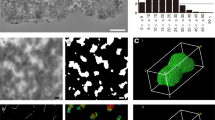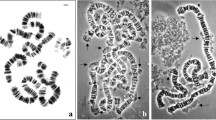Abstract
THE resting nucleus of Rhinanthus minor Ehrh. is characterized by the presence of a variable number of irregular bodies which stain with Feulgen's stain. These bodies were described as occurring in the genus Alectorolopus (= Rhinanthus) by Witsch1, who regarded them as fused chromocentres. There are usually four to eight of the bodies in the resting nucleus although the number varies between one and fourteen. They are visible under certain conditions in the living cell and cannot therefore be regarded as artefacts due to fixation. There is usually one nucleolus (rarely two) in the resting nucleus. Each nucleolus is closely appressed at one or more points to one or more of the stainable bodies. The connexion is such that, where a single nucleolus is present, it is sometimes pulled into a spindle shape, more rarely a triangle or rectangle, the two, three or four points of contact with the stained bodies representing the respective apices of these figures.
This is a preview of subscription content, access via your institution
Access options
Subscribe to this journal
Receive 51 print issues and online access
$199.00 per year
only $3.90 per issue
Buy this article
- Purchase on Springer Link
- Instant access to full article PDF
Prices may be subject to local taxes which are calculated during checkout
Similar content being viewed by others
References
Witsch, H., Österr. Bot. Z., 81, 108 (1932).
Author information
Authors and Affiliations
Rights and permissions
About this article
Cite this article
HAMBLER, D. Prochromosomes and Supernumerary Chromosomes in Rhinanthus minor Ehrh.. Nature 172, 629–630 (1953). https://doi.org/10.1038/172629a0
Issue Date:
DOI: https://doi.org/10.1038/172629a0
This article is cited by
-
Cytology of the Scrophulariaceae and Orobanchaceae
Nature (1954)
Comments
By submitting a comment you agree to abide by our Terms and Community Guidelines. If you find something abusive or that does not comply with our terms or guidelines please flag it as inappropriate.



